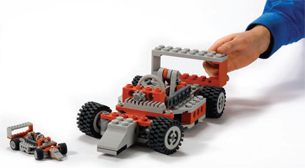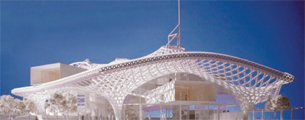Beyond Plastics: The Latest in RP&M Material Options, 2 in a Series
Current and upcoming material options push the envelope with flame retardancy, high temperature tolerance, and flexibility.
Latest News
February 2, 2009
By Susan Smith
« Page 1 |2
Stereolithography Materials
The first company to market stereolithography was 3D Systems. The basic process of building a part in stereolithography (STL) is as follows: an operator will load the STL file from CAD data into proprietary software, which slices the model into thin layers (approximately 0.005 in.) and produces a removable stabilizing structure around the part during the build process. The slice data is output to the SLA.
The second part of the process is the physical build where a vat of liquid photo-curable resin and an elevator table is set below the surface of the resin in the vat. The process then involves a computer optical scanning system with a laser beam focused so that it solidifies the 2D cross-section to correspond to the slice on the surface of the liquid resin. After a layer is complete, the elevator table descends to cover the solid polymer with another layer of liquid resin. This process is repeated with a wiper system moving across the surfaces to lay down the next layer of resin on the surface.
The part is built in this way from the ground up, until it is completed. Then it is put in a UV oven to be cured. Once this is finished, the part must be hand-finished to remove the support structure and smooth surfaces, such as the stair-step ridges that appear as a result of building up the part in multiple layers.
The strength, accuracy, and surface finish of stereolithography parts is reliant on layer thickness, materials, and postprocessing.
 Z Corporation printers have full, 24-bit color capabilities using colored binder materials so they can produce millions of distinct colors. In addition, the company’s introduction of HD3DP (highdefinition 3D printing) capabilities makes it possible for users to produce models with complex geometries and small, detailed features. |
Z Corporation
Currently Z Corporation provides the only color 3D printers produced for the manufacturing, GIS, and AEC markets. From Z Corporation comes a variety of powder/binder/infiltrant systems for different manufacturing needs. Their 3D printers operate like 2D desktop inkjet printers, with multiple print-heads to support full-color printing. Parts can be printed at the rate of 25mm (1 in.) vertical per hour.
Z Corporation printers have full, 24-bit color capabilities using colored binder materials (cyan, magenta, and yellow, just like a 2D printer), which allow them to produce millions of distinct colors. Users can also add annotation, engineering labels, and texture maps. In addition, the company’s introduction of HD3DP (high-definition 3D printing) capabilities makes it possible for users to produce models with complex geometries and small, detailed features.
High-performance composites for printing high-definition parts include investment casting material for parts that can be dipped in wax to produce investment casting patterns; and direct casting material for creating sand-casting molds for non-ferrous metals. Postprocessing such as sanding, drilling, painting, and electroplating can be added to Z Corporation models.
High-performance composites include Zp 131, a multipurpose material system that delivers strong parts, excellent resolution, and great color accuracy. It is perfect for fit and functional testing.
Zp 140 is a composite material that introduces an easy, safe, and green postprocessing option for finishing monochrome 3D printed models — just a quick mist with tap water.
This pure water misting finishes monochrome parts to their finished strength with no additional process, is virtually cost free, and also provides bright whites said to be 180 percent whiter than before processing.
Casting Materials
For direct metal casting, Z Corporation’s ZCast 501 Direct Metal Casting process makes it possible to produce cast metal parts from a CAD file by printing molds and cores directly from digital data. The process involves metal poured directly into the 3D printed molds. The direct casting material, a combination of foundry sand, plaster, and other additives together create strong molds with good surface finish, designed to withstand the heat involved in casting sand-casting molds for non-ferrous metals.
For investment casting, Zp 14 Investment Casting Material can fabricate parts that can be dipped in wax to produce investment casting patterns. Consisting of a mix of cellulose, specialty fibers, and other additives, this material is good for accuracy in parts, at the same time it maximizes the absorption of wax and minimizes residue during the burn-out process.
Elastomeric material consists of a mixture of cellulose, specialty fibers, and other additives combined for an accurate part that can absorb the elastomer, thereby giving the part its rubber-like qualities.
 Photo of an architect’s model created by Ogle Models, a rapid manufacturing and prototyping specialist in Letchworth, UK. Plastics laser-sintering of complex architectural designs from CAD models is much faster than producing them by hand. Ogle models uses the EOSINT P 385, the P 730, and the Formiga 100 in its prototyping and manufacturing work. |
Finished Z Corporation parts cost $.10/cc in materials. According to company literature, a handheld part can be produced for about $10 in material costs. Unusual in the business is that Z Corporation 3D printers recycle all unused material, which is an added benefit to the customer, as the customer only pays for the material actually used to produce a part.
Objet Geometries
A relatively new company, Objet Geometries is unusual in that it maintains its own chemists in house to develop materials. Its process is unique: PolyJet Photopolymer Jetting Technology is the process of jetting the photopolymer through an inkjet printhead instead of using a vat of resin, achieving high accuracy and resolution (600 x 600 dpi). The resin is cured with a UV light instead of a laser beam. Objet produces some useful materials to be used exclusively with its Eden line and its new desktop Alaris30 3D printers, namely, “ultra-thin-layer, high-resolution 3-dimensional printing and materials that utilize PolyJet and PolyJet Matrix polymer jetting technologies to print ultra-thin layers.”
Not only are the layers thin, but Objet can jet more than one layer at a time with its patented technology, which is not something you can do with other STL processes.
Objet’s materials are proprietary FullCure photopolymer materials that are jetted in 28µ layers. For the Alaris30, a VeroWhite model material and a gel-like FullCure Support material are jetted synchronously in identical amounts onto the build tray. The support-structure geometry makes it possible to make complicated geometries, such as cavities, overhangs, undercuts, delicate features, and walls as thin as 0.6mm. After the build is complete, users can easily remove the nontoxic support material by water jetting or by hand, and the model can be submitted for fit, form, and function testing. Also it can be painted, drilled, chrome-plated, or used as molds for tooling.
According to company literature, DurusWhite, FullCure430 Polypropylene-like material simulates the toughness (notched Izod impact of 40.22 J/m), flexibility (elongation at break of 44.2 %), and strength (modulus of elasticity of 1135MPa) of polypropylene. It can be used for food containers, industrial molds, car parts, and plastic parts.
Direct Metal Laser Sintering
Although direct metal laser sintering (DMLS) obviously doesn’t come under the same heading as plastic, it’s worth taking note of here. The process is considered an “additive” technology, using much the same method as laser sintering, as it sinters very fine layers of metal powders, building one layer on top of another, until the build is finished.
The latest technology uses a “dual spot” laser, according to Morris Technologies of Cincinnati, that allows feature sizes as small as 0.203mm to be built. The machine build envelope is 250mm x 250mm x 215mm, which makes it possible to built many medium to small parts within hours and days using cobalt chrome and titanium alloy. It can also process some steels and aluminum, plus gold for jewelry and dental applications.
According to Terry Wohlers of Wohlers Associates, Inc., most of the work in this area is done using titanium alloy and cobalt chrome for orthopedic companies and dental work.
There is also a lot of potential for metals in the area of aerospace design. Arcam and EOS are two of the most popular companies providing machines with their materials. EOS provides laser sintering as well as direct metal laser sintering.
More Info:
3D Systems
Rock Hill, SC
Arcam
Mölndal, Sweden
DSMSomos
Elgin, IL
EOS
Munich,Germany
Huntsman
The Woodlands, TX
Objet Geometries
Rehovot, Israel
Quickparts
Atlanta, GA
Stratasys
Eden Park, MN
Wohlers Associates
Fort Collins, CO
Z Corporation
Burlington, MA
Susan Smith is a contributing editor for Desktop Engineering magazine. She has been an editor and writer for the technology industry for more than 15 years and resides in Santa Fe, NM. Send e-mail about this article to [email protected].
« Page 1 |2
Subscribe to our FREE magazine, FREE email newsletters or both!
Latest News
About the Author
DE’s editors contribute news and new product announcements to Digital Engineering.
Press releases may be sent to them via [email protected].






